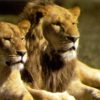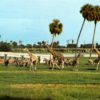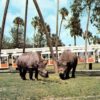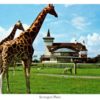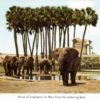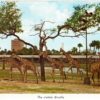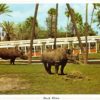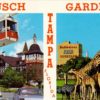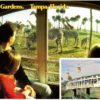The Serengeti Plain at Busch Gardens Tampa is an expansive habitat home to a number of African species including giraffe, rhinoceros, and zebra.
Today
The Serengeti Plain is best viewed by riding the Serengeti Express or Skyride. Great views of the southern portion of the plain can be had from Edge of Africa, or by dining at the Serengeti Overlook Pub or Treetop Kitchen. You can also catch glimpses of the plain while riding Cobra’s Curse, Montu, or from the pathways in the Nairobi section of the park.
For an even closer look, including the chance to feed giraffes, guests can choose the upcharge Serengeti Safari.
Known as the Serengeti Plain today, the sprawling animal habitat has also been called African Veldt and Wild Animal Kingdom in the past.
History
The Serengeti Plain as we know it today traces its history to before the park’s opening. Along with the Anheuser-Busch Brewery and accompanying 15-acre public park (which included much of the present-day Bird Gardens area), over 100 additional acres were to be set aside as a preserve for the company’s retired Clydesdale horses and about 100 other animals including deer, buffalo, zebras, ostriches, kangaroos, Sicilian donkeys, black angus cattle, Mouflon goats, and aoudad sheep. A newspaper article in March 1959 cataloged some of the animals already on site in pastures including “English stag, three fallow deer, 33 head of Black Angus cattle, two American buffalo, and two Clydesdale horses.”
By the park’s first anniversary, some of the ostriches had unfortunately met their end when a pack of wild dogs from the nearby neighborhood managed to get into their enclosure and attacked them.
An American Bison heifer weighing 25 pounds was born at noon on June 3, 1960. Named Annie Oakley, it was the first bison born at the park. The bison’s mother, Cody, and father, Bill, were both born and raised at the Busch family’s Grant’s Farm in St. Louis before being moved to Tampa. With the birth, the herd at the park numbered 13. The original dozen were purchased from a herdsman in Oklahoma for Grant’s Farm and moved to the park the previous year.
In early 1961, the park received its first two reticulated giraffes, Raggedy Ann and Andy, from the Cheyenne Mountain Zoo. Little Britches, a Masai giraffe from Cleveland Zoological Gardens, was the next to arrive. Jimmy, a Nubian reticulated giraffe, was the third to arrive at the park. He was the last to be born at the Ringling Brothers’ headquarters in May 1956 and was purchased by Busch Gardens from Clyde Beatty, a circus owner based in Hollywood, Florida.
According to an April 1961 newspaper article, the park made a bid for some of the animals from the closing Africa USA attraction in Boca Raton. The South Florida attraction housed some 500 African animals, including zebras, camels, antelopes, elephants, giraffes, cheetahs, and more. Two female giraffes, Moneybags and Enid, joined the herd at Busch Gardens and were believed to be pregnant when they arrived in Tampa.
The six giraffes were just a few of the over 100 African animals on property by early 1962. While not officially on display to Busch Gardens guests, they could sometimes be seen from the parking area or along the roadways bordering the park property.
On May 25, 1962, the park announced a 3.5 to 4 million dollar expansion program, to include an authentic American Plains area located north of the brewery (roughly where present day Stanleyville and Pantopia are located) and an African Veldt section located east and northeast of the facility. Animals on display in the new African Veldt were expected to include elephant, zebra, giraffe, black buck antelope, eland, camel, mouflon sheep, ostrich, gnu, aoudad sheep, and five monkey species. A miniature train on a 2-mile route around the habitats was also planned. The goal was to make the area look authentic, with plans for a 2.5-acre lake, two watering holes, and a 3/4-mile long “river” in addition to other landscaped features.
An expansion plan illustration was shared with the announcement. It showed the overall layout for the expansion, including several species and waterways planned for the African-themed section. It also shows the planned route for the train ride and two stations. Most interesting is the inclusion of a proposed monorail route, although that attraction was not part of the announcement and was not labeled in the concept illustration. A ‘Boat Landing’ is also marked on the northern end of the African Veldt, though articles covering the announcement did not mention this feature.
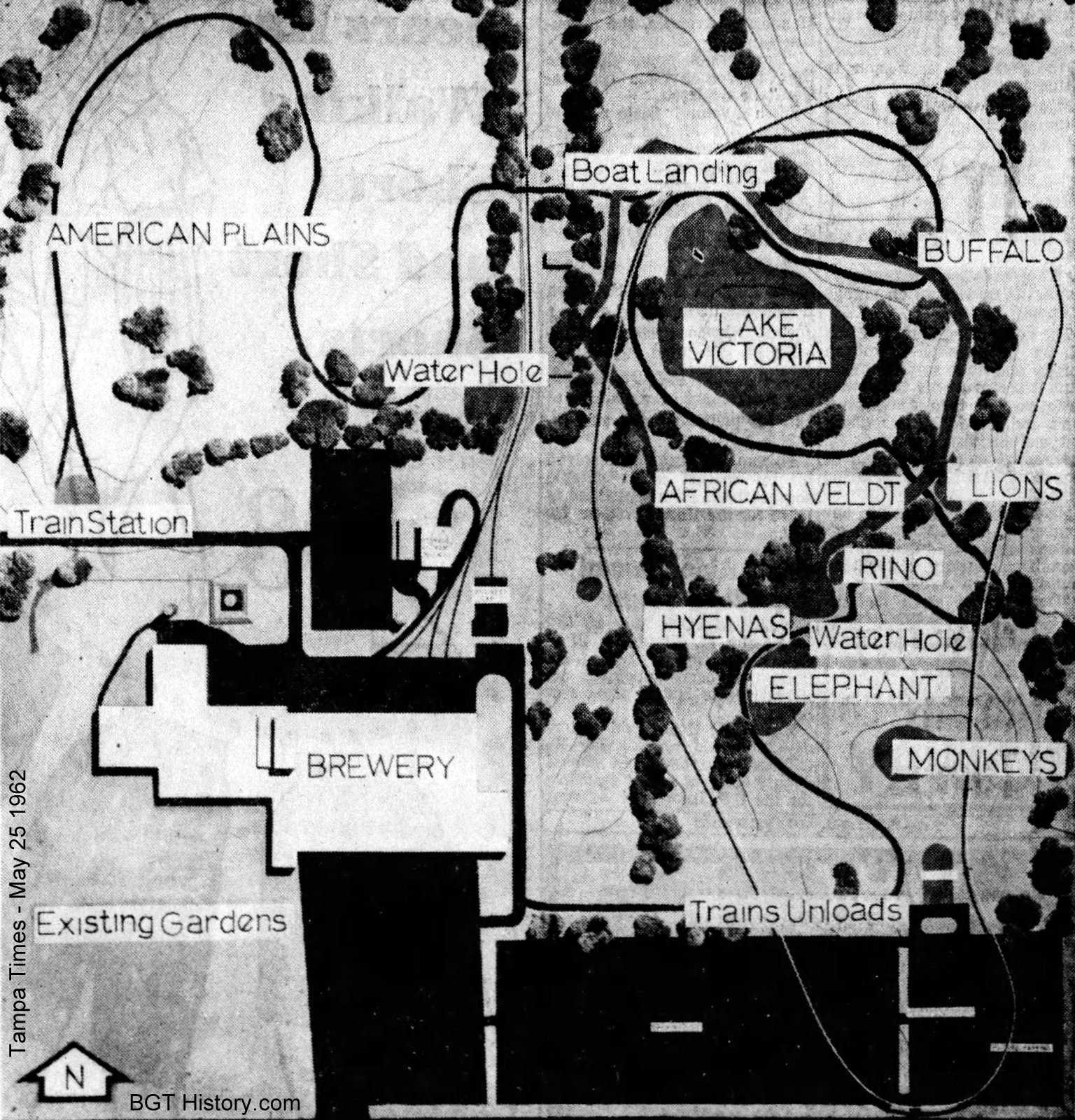
Work was initially expected to be completed by the end of 1962, however, the project ran into several delays. According to Anheuser-Busch president August A. Busch Jr., additional research was needed to ensure the new areas were authentic. Permits to import animals to Florida were also taking longer than expected. Busch was in talks with state officials on some of the issues the project was facing and discussed the possibility of Busch Gardens becoming a government-recognized zoological facility.
Early in 1963, the park announced a monorail would also be coming as part of the 4 million dollar expansion planned announced the previous May. The plans included the Skyrail to have a mile-long route, reach a maximum of 35 feet in height, and wind its way through the planned African Veldt area.
An aerial image of Busch Gardens in November 1963 showed the progress made on the project to the east and north of the brewery. Along with earth moving for the plains and veldt areas, a large clearing for an expansion of the parking lot can also be seen on the south side of the property (right side of the image).

Work continued into 1964. By June, nearly two dozen animals were already in their new habitats in the Veldt and Plains areas, with all of the new animals expected to arrive at the park by September. The number of new animals was expected to reach into the hundreds. Species that were listed to be on display in the new areas included cheetah, white rhinoceros, addax, blesbok antelope, cape hartebeest, kori bustard, elephants (including Indian and Asiatic), greater kudu, nubium ibex, chimpanzee, gorilla, and eight giant elephant tortoises.
Most of the new animals adapted well to their new habitats, and the goal was to begin breeding several of the species after the project was complete. However, such a large undertaking and moving so many animals was not without issue. In addition to the earlier permitting delays, some animals arrived at the park sick, and others encountered difficulties adjusting to their new home. Of the five elephants moved to the park, three adjusted well to their new surroundings, but two unfortunately died. Staff veterinarian Dr. E. E. Schobert stated it was likely the stress of changing environments that led to their decline in health. Tissue samples were taken and studied so that teams could learn more about what may have led to their deaths. Natural behaviors were also cause for some of the medical issues, including a male eland that used its horns to kill a female. An ostrich with several lacerations was saved due to the quick work of Schobert and his team, who stabilized the large bird in the field and stitched it up.
A 1967 newspaper article described Wild Animal Kingdom as a habitat with “numerous gazelle, sheep, goats, and antelope. Wildebeest, Eland, Gemsbok, Springbok, Cape Hartebeest, Nyala, Sitatunga, Beisa, Oryx, Uganda Kob, and Lady Gray’s Waterbuck, plus numerous related species also are present. The more commonly known animals such as giraffes, Arabian camels, zebras, rhinoceros, elephants, hippopotamus, cheetahs, lions, gorillas, and chimpanzees, plus flocks of African birds also make their homes in the Kingdom.”
The article described different areas of Wild Animal Kingdom including Gorilla Island along the “Congo River,” Goat Mountain, and “Lake Victoria.” The Skyrail (monorail) passed by many of these locations. The article also mentioned the park was home to more than a dozen lions, including a pride of cubs recently born at Busch Gardens.
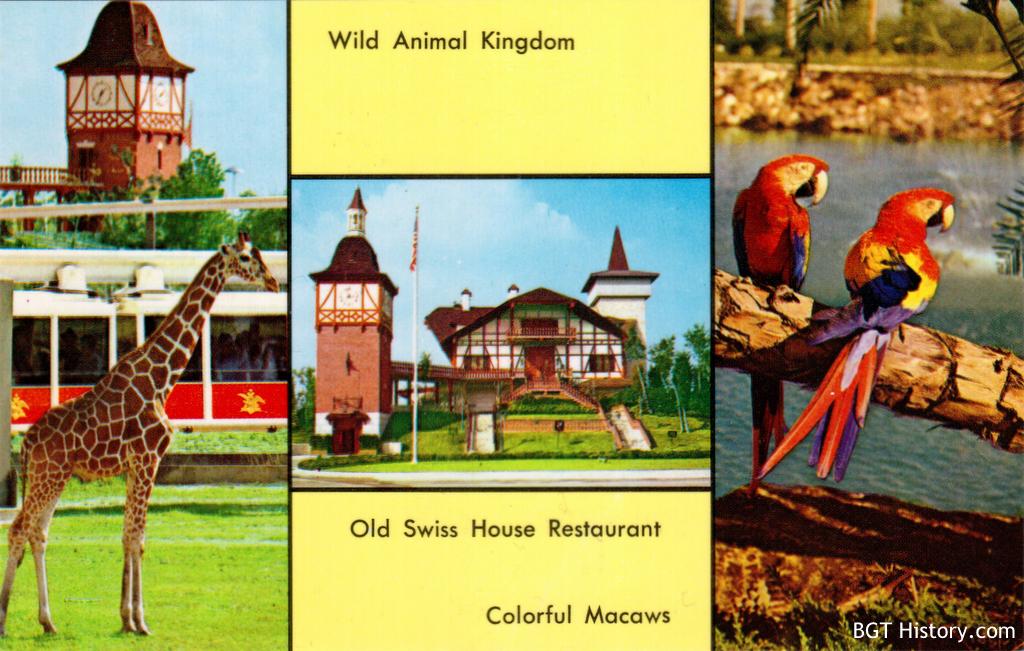
In the first week of September 1967, several sinkholes up to about 12 feet in diameter were discovered in the Wild Animal Kingdom while the park was closed for a week for annual general maintenance. A park spokesman at the time said there was no danger to guests.
A 1974 map of the park named the area African Veldt, which also included the Monorail Station, Veldt Theater, Old Swiss House, and Monorail Boutique gift shop. The park by that point was recognized as a “survival center” for many endangered species and was sanctioned by the USDA. The Trans-Veldt Railway provided tours of the Outer Veldt while the Monorail Safari provided tours of the Inner Veldt. Views of the northern end of the area could be had from the three-story Treetops stop on the railway.
As of early 1976, it was estimated there were around 800 animals representing nearly 100 different species who called the veldt home.
Busch Gardens became the first zoo in the country to successfully hatch Marabou storks in 1978.
On November 1, 1999, the park announced enhancements were coming to the Serengeti Plain. Work was focused on the southern portion of the plain near Edge of Africa, including on a 21-acre plot making one seamless 29-acre area. The project aimed at creating a more dynamic habitat for the different species that called the area home, including the addition of rolling hills, elevated terrain, and seemingly barrier-free views. The Serengeti Express also received a realignment as part of the project.
From the press release:
Additions to the new environment include expansive berms, the largest of which is four acres; tiered and open landscapes covered with native and African grasses, scrub trees and shrubs; rock outcroppings and bluffs replicating natural formations; and naturalistic creek beds and mud banks. The Plain will feature nearly 700 trees including 26 species of Acacia, 7,000 shrubs such as Cape Honeysuckle and Burgandy Fringe Flower, and more than 21,000 short and tall grasses, Giant Reed and Red Fountain grasses included. A number of bamboos including Arrowleaf and Henon Timber also will cover the acreage. In total, more than 150 species of vegetation will be represented… In addition to landscape enhancements, a new behind-the-scenes 3,600 square-foot giraffe barn is being constructed and connected to a 10,000 square-foot habitat designed for additional animal care. The park is also constructing an off-view 6,000 square-foot hoofstock habitat.”
The engineer for the project was listed as Mark Rose, vice president of design engineering at Busch Gardens; architect Peckham, Guyton, Albers and Viets, Inc.; landscape architect Foster, Conant and Associates.
The announcement for the project came during a dedication for the new offsite Busch Animal Outpost located outside of Dade City in Pasco County. The 108-acre site featured 17 different habitats ranging in size from one-quarter to one acre for various animals. At the time of the dedication, about 50 animals were housed there including some who were temporarily relocated from the park while improvements were being made to the Serengeti Plain. The outpost, not accessible to the public, included a full-time resident curator living in a ranch-style home on the property, along with zookeeper and veterinary staff with 24/7 coverage on-site.
The enhancements to the Serengeti Plain were dedicated on June 23, 2000, with a special ceremony. A golden spike was set into place on the Serengeti Express Railway by members of Riverdance: The Show who were performing at the park as part of a national tour.
A park blog post in March 2012 detailed the recent birth of three giraffes. A female giraffe named Tinsel was born the week prior to Christmas 2011. The second birth was female Cofi, which is Swahili for “born on Friday.” A third male calf was born to mother Celina, and Facebook users chose Madoa as his name, meaning “spots” in Swahili. The other choices were Kuvuka and Kubwa.
A 140-pound baby female white rhinoceros was born in the early morning hours on Tuesday, October 23, 2012, on the 26-acre white rhino habitat on the Serengeti Plain to mother Kisiri and father Tambo. It was the second calf born to Kisiri, and the seventh to Tambo. Kisiri, Tambo, and another female white rhino were airlifted from Kruger National Park in South Africa in 2001 through the efforts of the International Rhino Foundation (IRF), a non-profit organization dedicated to the protection of rhinos.
The rhino and its mother joined others on the Serengeti Plain on November 1, 2012. A Facebook poll was used to allow fans to choose the new rhino’s name from these four options:
- Bahati, meaning luck or success
- Jasiri, which means brave and bold
- Safiri, which means traveler
- Saba, which refers to her being the seventh white rhino born at Busch Gardens
It was announced on November 8, 2012, that the winning name was Jasiri.
In 2013, three new species were introduced to the Serengeti over the course of several months – sable antelope, springbok, and Grant’s gazelle.
As of June 2014, more than 20 giraffes resided at the park.
For Halloween 2014, Busch Gardens shared a video of Forest, a black rhinoceros, enjoying some special enrichment:
As of World Giraffe Day on June 20, 2015, the park was home to 14 reticulated giraffes, ranging in age from 1 to 20 years old. More than 50 giraffes had been born at the park since 1984.
On September 18, 2015, the park announced Kisiri, an 18-year-old southern white rhinoceros, was expected to give birth to her third calf within a few weeks. Kisiri had two successful births prior at the park – Jasiri in 2012 and Zohari in 2010. Tambo, a male southern white rhino was the sire.
The park celebrated World Rhino Day the following day on September 19 near the Nairobi Train Station with an event tent. Crafts, trivia, rhino artifacts, and educational activities were offered. Guests could help create a large paper mache globe that was given to the rhinos as enrichment later in the day. At the time, the park was home to two species of rhinoceros.
Kisiri gave birth to a healthy female southern white rhinoceros on October 16, 2015. The park shared a video of the calf and mother a few days later:
Guests were allowed to choose the new rhino’s name through a Facebook poll. They chose Nyota (Knee-yotah) meaning “star.”
As of November 2016, the oldest giraffe at the park was 21-year-old Tesa.
In March 2017, a baby Kudu was named Stewart in honor of new park president Stewart Clark.
On June 1, 2017, a permit was filed with the City of Tampa for a tree consultation. The permit was the first step in the process for the removal of protected trees, and the filing mentioned the purpose as “future expansion” of the park. Tampa has regulations protecting trees of a certain diameter. Protected trees include those with a trunk diameter of at least five inches. Even greater protections exist for “grand trees” with a trunk diameter of 34 inches or more, among other qualifications. For a grand tree to be removed in the city, it must be considered hazardous, pose a risk of structural damage, or prevent reasonable use of the land where that use can not be reasonably reconfigured to leave the tree standing.
City inspectors visited the area of the park pertaining to the permit application which was along the northern edge of the Serengeti Plain around the train tunnel and also included nearby animal holding pens. A total of nine grand trees and a number of other protected trees were noted in the report filed by the inspectors. At the time, there was no announcement on what the expansion in that area might be, with the park declining to share any details on the purpose of the permit application.
Patty, a female giraffe born just before St. Patrick’s Day 2018, joined the herd on the Serengeti Plain in July 2018.
A male giraffe was born to mother Bea on June 19, 2020, weighing in at 100 pounds and standing five feet tall.
The giraffe would later be named Beacan and made his debut on the plain towards the end of 2020. The park shared a short video update in early December.
On March 9, 2021, the park shared a social media post introducing a two-month-old giraffe calf named Cedora.
Jody, the black rhinoceros living in the habitat between the north and south portions of the Serengeti Plain, received some special Independence Day themed enrichment just before the 4th of July in 2021.
Born on July 7, 2021, the night the Tampa Bay Lightning won the Stanley Cup, a male giraffe was born. The choice of a new name was easy for the park – the following week they introduced Stanley on social media.
In celebration of World Rhino Day on September 22, 2021, the park shared a unique video showing the prehensile lip of the black rhino in action:
The park shared a video highlighting several species at Edge of Africa and the Serengeti Plain enjoying some special enrichment celebrating Halloween 2021.
Beginning in November 2021, Stanley the giraffe joined the rest of the herd out on the plain.
Animal Births
Below is a list of some of the many animal births that occurred at the park of species on the Serengeti Plain over the years:
- September 1982 – A male cape buffalo is born at the park, named Gordon.
- February 25, 2011 – A female Thomson’s gazelle is born, weighing just over four pounds. When the calf refused to take milk from her mother, the animal care staff stepped in to hand-raise her.
- Late Spring 2011 – Five impala calves are born – two females and three males.
- July 17, 2011 – A female eland calf is born at the park.
- August 22, 2011 – A female eland calf is born at the park, weighing 50 lbs. It’s the second eland birth of the season, bringing the herd to a total of 11.
- September 21, 2011 – A female Cape buffalo is born to mother Semara, weighing about 45 pounds.
- November 4, 2011 – A female Grant’s zebra is born. Within an hour, the foal was running with the herd and nursing from her mother.
- December 27, 2011 – A female reticulated giraffe is born to mother Tesa and father Jafari. The giraffe measured in at 5’7″ and 127 pounds. Tesa previously gave birth to four other calves at the park. The birth brings the reticulated giraffe population at the park to 18.
- January 27, 2012 – A baby female reticulated giraffe is born. At 6 feet, 2 inches tall, and weighing approximately 176 pounds, the newborn is the calf of father Jafari and mother Cupid. This is Jafari’s second calf and Cupid’s fifth.
- July 30, 2012 – A male eland calf is born, weighing in at 53 pounds. The park hand raised the calf as its mother was not taking care of it. The hand-raising included 5 bottle feedings a day for the first month. Once large and healthy enough, the calf joined the other 11 elands on the South Veldt.
- October 23, 2012 – A female white rhinoceros is born on habitat to mother Kisiri and father Tambo. The rhino is later named Jasiri.
- June 11, 2013 – Cupid, a 15-year-old giraffe, welcomed her seventh calf. The male calf weighed 188 pounds and was more than 6 feet tall.
- June 19, 2013 – Tesa, an 18-year-old giraffe, welcomed her sixth calf, a female weighing 145 pounds and standing 5 feet 8 inches tall.
- August 5, 2013 – An endangered Grevy’s zebra was born on the Serengeti Plain. Within an hour after its birth, the baby was able to stand on its own and nurse from its mother Brooke. Brooke was a 13-year-old Grevy’s zebra at the time and welcomed her fifth foal. The new foal was the first offspring to father Two Step. In addition to the new foal, seven females and one male Grevy’s zebras lived on habitat at the time of the birth.
- March 12, 14 & 18, 2014 – Three reticulated giraffes were born to mothers Bititi, Tequiza, and Celina. The births included two females, both who measured 5 feet, six inches, and weighed in at over 100 pounds, and a male who measured more than six feet tall and over 150 pounds.
- April 3 & 5, 2014 – A total of three marabou stork chicks were hatched on the plain to first-time parents Fig and Reba. Fig was also hatched at Busch Gardens more than 10 years earlier.
- November 28, 2014 – A female Grant’s gazelle is born on Thanksgiving Day, bringing the herd size to six at the park. The herd spent several months behind the scenes before being reintroduced to the Serengeti Plain.
- July 7, 2015 – A baby white-bearded wildebeest is born at the park, weighing approximately 40 pounds.
- July 18, 2015 – A female Grant’s gazelle is born at the park.
- September 2, 2015 – A male wildebeest is born.
- October 16, 2015 – A female southern white rhinoceros, later named Nyota, is born to mother Jisiri and father Tambo.
- Late 2015 – 8 impala calves are born at the park. They later join the herds on the southern Serengeti Plain in February after several months of bonding behind the scenes.
- December 2016 – Nine recently born nyala go on habitat.
- October 2, 2017 – Winnifred, or Winnie for short, a female white rhinoceros, is born at the park. She weighed 140 pounds at birth.
- November 23, 2017 – On Thanksgiving Day, Quinn, a male reticulated giraffe, is born to mother Celina. He weighed 150 pounds and measured six feet tall.
- January 2018 – Park announced the recent birth of a female giraffe named Angel.
- March 16, 2018 – Patty, a female giraffe, is born at the park on the eve of St. Patrick’s Day. She stood at five feet five inches tall and weighed 105 pounds, and was the third giraffe birth in four months at the park.
- June 19, 2020 – A male giraffe named Beacan is born to mother Bea.
- January 2021 – A female giraffe, Cedora, is born.
- July 7, 2021 – A male giraffe, Stanley, is born to mother Angel. This was Angel’s first calf.
Images
Some of the postcards through the years feature views of the plain and some of the wildlife that called the expansive habitat home:
An undated photo shared by the park shows the southern edge of the Serengeti Plain and Old Swiss House, with several species, including giraffes and zebras visible:
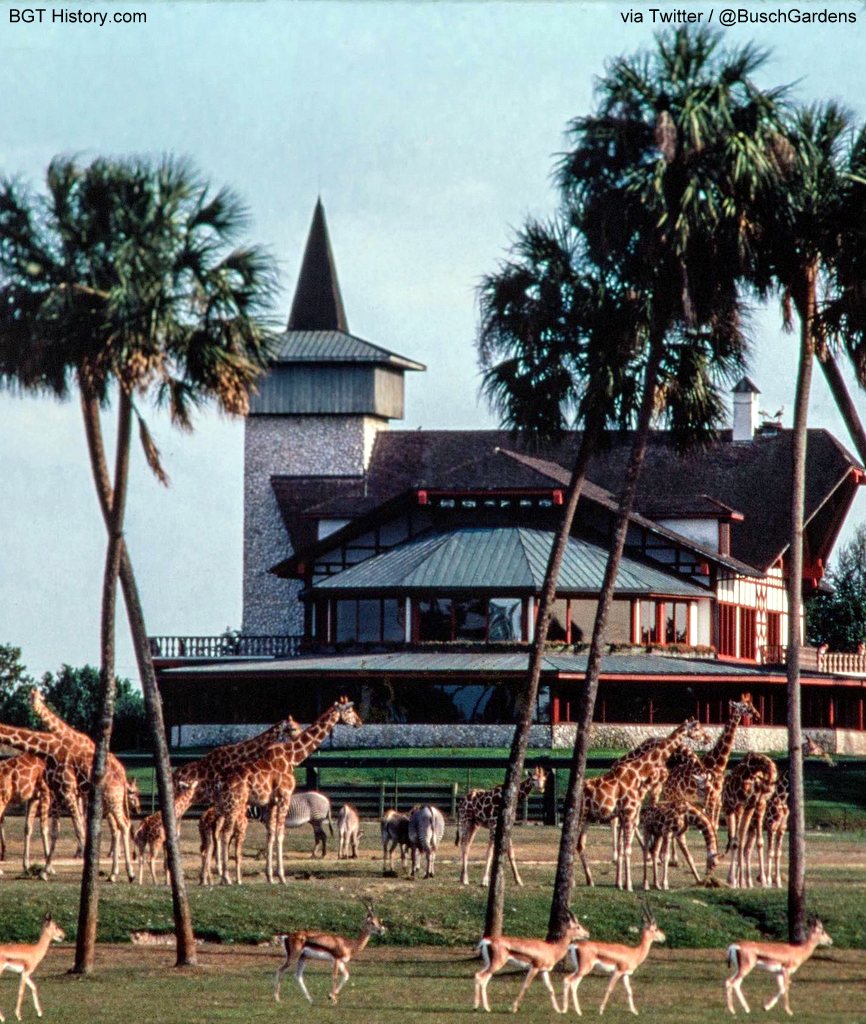
Additional information and images on the Serengeti Plain at Busch Gardens Tampa may be added in the future.
Sources:
Park Brochure – Late 1960s (Author’s Collection)
Tampa Tribune | Mar 9 1959
Tampa Times | Mar 30 1959
Tampa Times | Mar 31 1959
Tampa Tribune | Jun 4 1960
Tampa Tribune | Jun 12 1960
St. Petersburg Times | Apr 17 1961
Tampa Tribune | Feb 4 1962
Tampa Times | May 25 1962
St. Petersburg Times | May 26 1962
Tampa Tribune | May 26 1962
Tampa Times | Jan 24 1963
Tampa Times | Nov 5 1963
Tampa TImes | Jun 3 1964
Boca Raton News | June 18 1967
Orlando Sentinel | Sep 8 1967
The Evening Independent | Feb 3 1976
The Ledger | Nov 19 1982
Ultimate Rollercoaster | Nov 1 1999
Ultimate Rollercoaster | Jun 23 2000
Ultimate Rollercoaster | Aug 23 2011
Busch Gardens Tampa Bay | Mar 30 2011
Busch Gardens Tampa Bay | Jun 14 2011
Busch Gardens Tampa Bay | Nov 3 2011
Busch Gardens Tampa Bay | Nov 9 2011
Press Release – Dec 29 2011
Press Release – Jan 27 2012
Busch Gardens Tampa Bay | Mar 23 2012
Twitter – @BuschGardens | Apr 5 2012
Busch Gardens Tampa Bay | Apr 12 2012
Busch Gardens Tampa Bay | Aug 16 2012
Press Release – Oct 24 2012
Busch Gardens Tampa Bay | Oct 30 2012
Busch Gardens Tampa | Nov 1 2012
Busch Gardens Tampa Bay | Nov 8 2012
Busch Gardens Tampa | Aug 8 2013
Busch Gardens Tampa | Aug 20 2013
Busch Gardens Tampa | Sep 24 2013
Busch Gardens Tampa | Sep 27 2013
Busch Gardens Tampa | Apr 25 2014
Busch Gardens Tampa | Apr 29 2014
Busch Gardens Tampa | May 8 2014
Busch Gardens Tampa | Jun 16 2014
Busch Gardens Tampa | Oct 29 2014
Busch Gardens Tampa | Dec 10 2014
Busch Gardens Tampa | Jun 12 2015
Busch Gardens Tampa | Jul 13 2015
Busch Gardens Tampa | Aug 13 2015
Busch Gardens Tampa | Sep 11 2015
Busch Gardens Tampa | Sep 18 2015
Busch Gardens Tampa | Sep 29 2015
Busch Gardens Tampa | Oct 20 2015
Busch Gardens Tampa | Nov 12 2015
Busch Gardens Tampa Bay | Feb 12 2016
Twitter – @BuschGardens | Nov 15 2016
Busch Gardens Tampa Bay | Dec 20 2016
Twitter – @BuschGardens | Mar 7 2017
Twitter – @androckb | Jun 1 2017
Touring Central Florida | Jun 15 2017
Twitter – @BuschGardens | Oct 5 2017
WFLA.com Nov 29 2017
Twitter – @BuschGardens | Jan 21 2018
Twitter – @BuschGardens | Mar 21 2018
Twitter – @BuschGardens | Jul 17 2018
Twitter – @BuschGardens | Jun 21 2020
Twitter – @BuschGardens | Dec 3 2020
Twitter – @BuschGardens | Mar 9 2021
Twitter – @BuschGardens | Jul 2 2021
Twitter – @BuschGardens | Jul 13 2021
Twitter – @BuschGardens | Sep 22 2021
Twitter – @BuschGardens | Oct 31 2021
Twitter – @BuschGardens | Nov 22 2021
Twitter – @BuschGardens | Mar 31 2022
Last update: April 12, 2025

